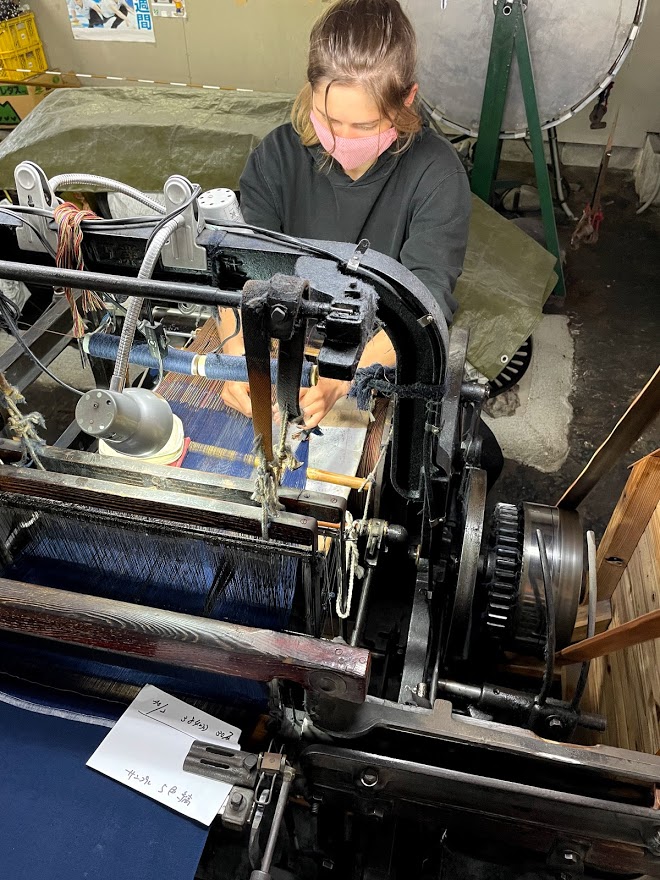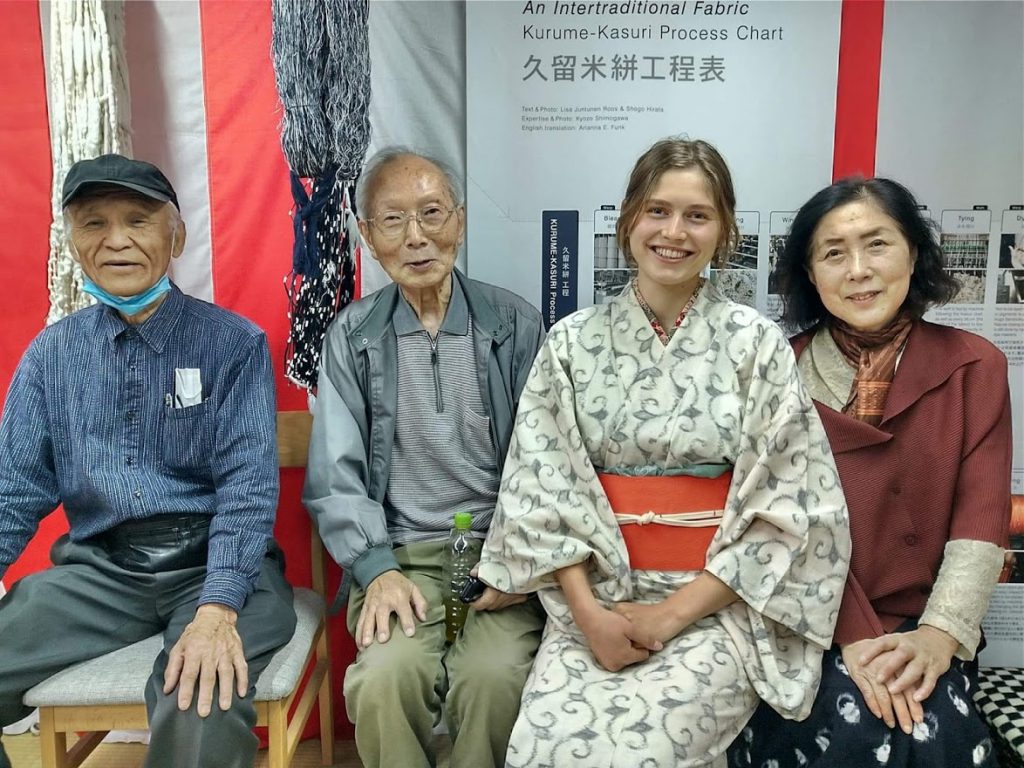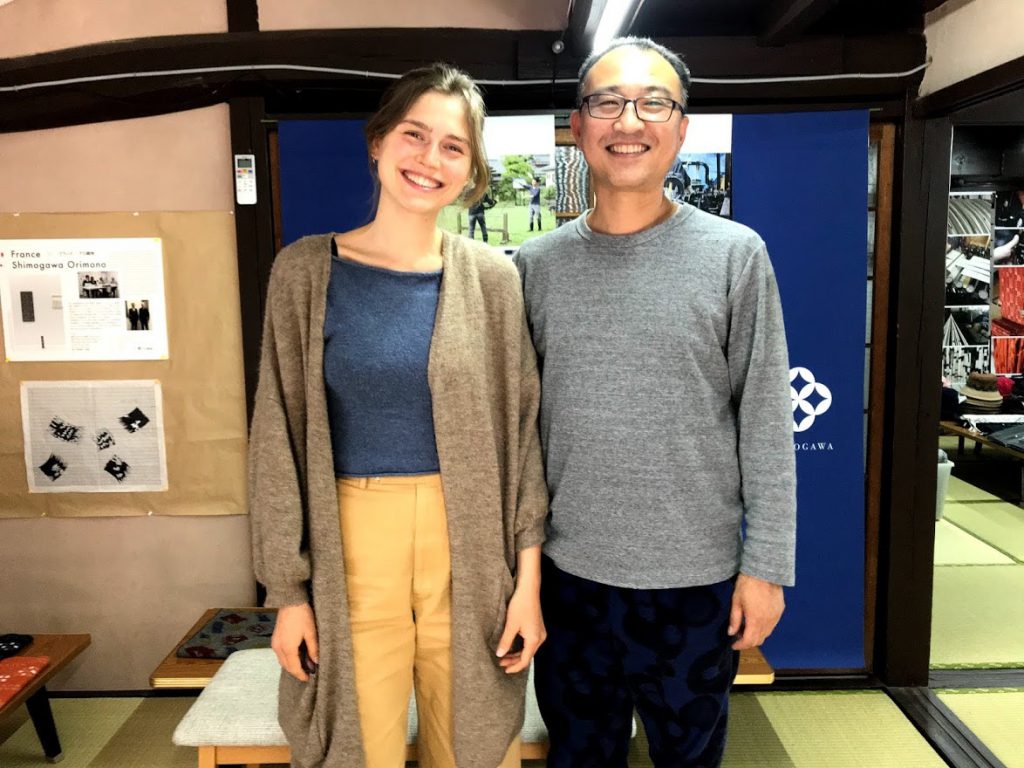久留米絣という名の未来を共有するインタビュー
2021年5月7日
Interview with Nadja-san
Self-introduction (past):
My name is Nadja Winter. I am 23 years old and a fashion design student at Burg Giebichenstein in Halle, Germany. In November 2020 I came to Japan as an exchange student to study “Textile Arts” at Tokyo Geijutsu Daigaku for one semester. My interest in Japan, especially in its crafts and culture, has been evolving since my childhood, passed on by my father. He has always been inspired by Japanese art and design, which he expresses through his work as an architect. As I started with my studies, I soon realized that through my strictly sustainable working ethos I myself often take recourse to Japanese minimalism. The greater was the opportunity to experience it all at first hand. Already during my exchange program I have noticed, that two months will not be enough and I am strongly seeking for more insights into traditional crafts. Since I was not able to extend my studies at Tokyo Geijutsu Daigaku, I was asking around my friends if they might know an atelier or factory that would take in interns. That is how I came across “Shimogawa Orimono”. I knew just a little about Kasuri beforehand. I knew that the yarn is being tied and dyed before being woven, but I was definitely not aware of how many steps and manual work is being invested to create this special textile. Thus I was more than looking forward to learn more about its technique. Particularly as a future fashion designer, I find it essential to experience every step of the textile chain in order to build up awareness towards the hard work put into a single garment.

Experience (present):
As my internship is reaching an end, I can definitely say I am happy about having extended my stay in Japan by coming to “Shimogawa Orimono”. I am more than grateful for this extraordinary experience they have given me, for their big-hearted hospitality and acceptance as well as their boundless openness of sharing their knowledge with me, especially in times of a pandemic. Anybody, who engages “Kurume Kasuri”, will soon take notice that this technique needs many years of experience for comprehension, for the fine sense and last but not least for its perfection.
Even though I have gotten the chance to learn and see a lot I am still at the beginning of understanding everything. For some more complex production steps, such as the computer program for the tying process or drawing on the warp yarn before weaving, the six weeks were not enough time to dive deep into them. It is also not usual besides the factory owner for every craftsman to be able to do every part of the production. Each of them specifies on one or a few and becomes the best in those particular ones. Having this in mind, I think I have been able to gain a rich overview, especially for being a complete beginner in the textile manufacturing. Like in all crafts, also here rules the motto: “learning by watching and doing” and that takes time. I have really developed such huge appreciation and respect for Kasuri and other traditional, especially all handmade, textiles. Everybody should gain back this knowledge about the production chain. We have to start valuing the work behind textiles and garments and support local production to maintain the beautiful traditions we inherit all around the world.

What now? (Future)
I will leave Japan with the various knowledges I have collected during my stay and spread those in my surroundings, where ever I will be. I am keen to maintain and support traditional crafts by raising awareness and teaching those to my fellows. I think this is the first step we need to take against mass consumption of fast fashion. People need to know about it in order to develop consciousness about their consumption behavior. Only then will people be willing to pay the rightful price of a product, meaning: “buy less, choose well, make it last”. We cannot rely on the government and companies solely, because unfortunately most put profit first. If we, as society, show them what we demand then they will have to adapt to those requirements. Of course all of this has to happen simultaneously. As said many times before, we all have a choice. Every choice we make will make a difference, even as insignificant as it might seem, but therefore we have to want to make a change. And we will be even more successful when we interconnect and team up. That is why I would love to maintain relations in Japan. We can all learn from each other. With a lot of colorful minds involved, innovative ideas will soon flourish. We need to shatter the competitive system and work together instead. The area surrounding Yame and Kurume is a perfect example. Designers, factories and retailers are in close contact working together. It’s a deeply intertwined system, in which one is depended on the other. Their mutual support lays the groundwork for the survival of this tradition. In terms of Kurume Kasuri, I really hope to be able to establish a cooperation with Kyozo Shimogawa in the future. If a suitable project possibility will arise that allows the required time and investment, I would be more than happy to work together. In this regard, I would be interested in starting a project that tries to completely ban chemicals during production drawing on primal practices. Nevertheless most factories really work close with nature and in its boundaries.
Beyond that, I am very certain that we will stay in close contact and will benefit from each other in the future.
Last but no least, a big thank you from my side goes to Kyozo Shimogawa, his family, (co)workers and friends for having me and giving me a precious memory. Mata chikaiuchini o ai shimashō!

(和訳)
自己紹介(過去):
私の名前はナディア・ウィンターです。私は23歳で、ドイツのハレにあるブルクギービヘンシュタインのファッションデザインの学生です。 2020年11月、交換留学生として東京藝術大学で1学期「テキスタイルアート」を学ぶために来日しました。私の日本への関心、特に工芸や文化への関心は、子供の頃から父に受け継がれてきました。彼は常に日本のアートとデザインに触発されており、建築家としての仕事を通じてそれを表現しています。勉強を始めてみると、厳密に持続可能な働き方の精神を通して、私自身が日本のミニマリズムに頼ることが多いことにすぐに気づきました。それをすべて直接体験する機会が大きかった。交換留学の途中で、2ヶ月では足りないことに気づき、伝統工芸への洞察を強く求めています。東京藝術大学で勉強を続けることができなかったので、友達にインターンを受け入れるアトリエや工場を知っているかどうか尋ねていました。そういうわけで「下川織物」に出会いました。かすりのことは少し前から知っていました。糸が結ばれて染色されてから織られることは知っていましたが、この特別なテキスタイルを作るためにどれだけのステップと手作業が費やされているかははっきりとはわかりませんでした。したがって、私はその技術についてもっと学ぶことを楽しみにしていました。特に将来のファッションデザイナーとして、一枚の服に込められたハードワークへの意識を高めるためには、テキスタイルチェーンのあらゆるステップを体験することが不可欠だと思います。

経験(現在):
インターンシップが終わりに近づいており、「下川織物」に来て、日本での滞在を延長できたことを嬉しく思います。彼らが私に与えてくれたこの並外れた経験、彼らの心のこもったおもてなしと受け入れ、そして特にパンデミックの時に彼らの知識を私と共有する彼らの限りない開放性に感謝しています。 「久留米かすり」を手がける人なら誰でも、この技法は理解、センス、そして完璧さのために長年の経験が必要であることにすぐに気付くでしょう。
たくさんのことを学び、見る機会を得ましたが、まだすべてを理解し始めています。括りプロセスのコンピュータプログラムや織りの前に経糸を描くなど、いくつかのより複雑な製造ステップでは、6週間ではそれらを深く掘り下げるのに十分な時間ではありませんでした。また、すべての職人が生産のすべての部分を行うことができるのは、工場の所有者以外には珍しいことです。それらのそれぞれは、1つまたはいくつかを指定し、それらの特定のもので最高になります。このことを念頭に置いて、特に繊維製造の完全な初心者であるために、私は豊富な概要を得ることができたと思います。すべての工芸品と同様に、ここでも「見て、やって学ぶ」というモットーがあり、それには時間がかかります。私は、かすりや他の伝統的な、特にすべて手作りのテキスタイルに、このような大きな感謝と敬意を払ってきました。誰もが生産チェーンに関するこの知識を取り戻す必要があります。私たちは、世界中で受け継がれている美しい伝統を維持するために、テキスタイルや衣服の背後にある仕事を評価し、地元の生産をサポートする必要があります。

今何? (未来)
滞在中に集めた様々な知識を持って日本を離れ、どこにいても周囲に広めていきます。私は、意識を高め、仲間に教えることで、伝統工芸を維持し、支援したいと思っています。これがファストファッションの大量消費に対抗するために必要な最初のステップだと思います。人々は彼らの消費行動についての意識を発達させるためにそれについて知る必要があります。そうして初めて、人々は製品の正当な価格を喜んで支払うことになります。つまり、「購入を減らし、適切に選択し、長持ちさせる」という意味です。残念ながら、ほとんどの人が利益を第一に考えているため、政府や企業だけに頼ることはできません。私たちが社会として、私たちが要求するものを彼らに示すならば、彼らはそれらの要件に適応しなければならないでしょう。もちろん、これはすべて同時に発生する必要があります。以前何度も言ったように、私たち全員に選択肢があります。私たちが行うすべての選択は、見た目は取るに足らないものであっても、違いを生むでしょうが、したがって、私たちは変更を加えたいと思う必要があります。そして、相互接続してチームを組むと、さらに成功するでしょう。だからこそ、日本での関係を維持したいと思っています。私たちは皆、お互いから学ぶことができます。たくさんのカラフルな心が関わって、革新的なアイデアはすぐに繁栄します。競争力のあるシステムを粉砕し、代わりに協力する必要があります。八女と久留米の周辺はその好例です。デザイナー、工場、小売業者は緊密に協力して取り組んでいます。これは深く絡み合ったシステムであり、一方が他方に依存しています。彼らの相互支援は、この伝統の存続のための基礎を築きます。久留米かすりに関しては、下川強臓との協力関係を築いていきたいと思います。
彼の未来。 必要な時間と投資を可能にする適切なプロジェクトの可能性が生じた場合、私は一緒に働くことを嬉しく思います。 この点で、私は、主要な慣行を利用して、製造中に化学物質を完全に禁止しようとするプロジェクトを開始することに興味があります。 それにもかかわらず、ほとんどの工場は実際に自然とその境界で密接に働いています。
それを超えて、私たちは密接に連絡を取り合い、将来的にお互いから利益を得ると確信しています。
最後になりましたが、私を迎えて貴重な思い出を与えてくれた下川強臓さん、その家族、(同僚)、そして友人たちに心から感謝します。 マタチカイウチーニオアイシマショウ!

<Nadja Winter ナディア・ウインターについて>
昨年秋からの東京藝術大学での交換留学期間を経て3月末から下川織物に滞在。一か月半の長期滞在を経て5月12日に再び東京へ戻った後、5月末にドイツに帰る。
彼女が下川織物でインターン生活をおくることになったきっかけもまた興味深い。下川織物は、2014年頃を境にグローバルな情報発信、より開かれた工房の在り方、新しいモノづくりを目指して精力的にさまざまな交流事業を行っている。その中で多くの人々と出会い、そのご縁の重なりの中でナディアが八女に来るところにつながっている。人の出会いは不思議な縁でつながっているところを改めて感じた。
今年の1~2月、東京滞在中のNadjaと2回のZOOM ミーティングを経て、3月末に初めて会ったときの第一印象は、とても自然に感じられ、翌日の朝から工場の中に入ってくる彼女を見てもまるで以前から居たように違和感を感じることがなかった。
彼女は、とても素直な性格で好奇心旺盛で人懐っこい性格のため、誰からも好かれる存在。私は、これまでに下川織物を訪問した人たちと同様に私の大事な友人を数多く紹介し交流の機会を作った。久留米絣のみならず日本の伝統や文化へ強い関心を持つ彼女にとっては、充実したインターン期間となったと確信できる。これを書き終えた数日後に彼女との別れの時間がやってくる。この別れが次の始まりになることは彼女のコメントからも容易に推測できる。
久留米絣織元 下川織物
E-MAIL info@oriyasan.com
instagram http://instagram.com/shimogawakyozo/
facebook https://www.facebook.com/shimogawaorimono
Twitter @kasuritter
Pinterest https://www.pinterest.jp/kyozos/_created/
YouTube https://www.youtube.com/channel/UCOZennIqkscFGNJLwnTOyKg